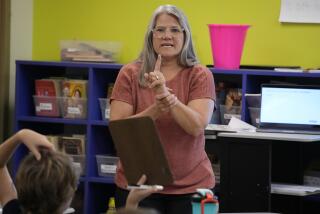George Lenchner, 88; Introduced Math Olympiads in Schools
- Share via
George Lenchner, an influential educator and textbook author who founded the Math Olympiads, an annual competition involving more than 150,000 students around the world, died April 23 in San Francisco. He was 88.
The cause of death was complications from a fall, his son, Eric, said.
Lenchner founded the Math Olympiads in 1978 as a regional competition for elementary and middle school students on Long Island, N.Y. Now schools in every state and 30 countries around the world hold the competition, which awards students for achievement in five monthly contests usually held from November to March.
Through the Olympiads, as well as his books and workshops, Lenchner promoted an approach to math instruction that made problem solving, rather than rote memorization and mechanical tasks, the ultimate goal.
“A lot of people think mathematics is a series of procedures and facts to be memorized,” said James M. Rubillo, executive director of the National Council of Teachers of Mathematics. “George was part of a whole movement that said children ... can find great joy in challenging situations that utilize their minds.”
To do so, Lenchner developed a sequence of problems that offered just enough of a challenge to stimulate students and help them attain confidence and competence in math.
“George got kids to say, ‘Give me the next problem!’ That’s a great gift,” Rubillo said.
Steven Leinwand, who was a math teacher and director of mathematics for Connecticut public schools for 22 years, was a calculus student of Lenchner’s in the mid-1960s. He now studies math education as a principal analyst for the Washington, D.C.-based American Institutes for Research.
“George was responsible for instilling in me a love of mathematics and mathematics teaching,” Leinwand said. “His gift was he communicated both his love of the beauty of mathematics and the practicality of mathematics. He had his head in the sky and his feet on the ground.”
Lenchner was born in Hartford, Conn., but moved to New York City as a child. He was a member of a championship math team in high school and studied classical piano, but gave up thoughts of a professional concert career to attend City College of New York from 1936 to 1939.
A weapons instructor and company commander in the 29th Ranger Battalion of the Army’s 116th Infantry Division, he was severely injured while leading his company in the second-wave landing on Omaha Beach on D-day, the June 6, 1944, Allied invasion of Nazi-held France. He spent a year recovering in British and American hospitals and was awarded the Purple Heart and Bronze Star.
He was featured in the book “They Were on Omaha Beach” by Laurent Lefebvre and in a current exhibition at New York’s Museum of Jewish Heritage called “Ours to Fight For: American Jews in the Second World War.”
After the war he returned to school, receiving a master’s degree in music from New York University in 1948. Grateful to be alive, the classically trained pianist applied his talent to the Borscht Belt circuit as accompanist to Moe Howard of Three Stooges fame.
In 1950, Lenchner decided that he really belonged in the classroom, not on stage, and became a high school math teacher. By 1953 he was math department chairman at Valley Stream North High School in Long Island.
In 1954, he founded the Nassau County Interscholastic Mathematics League for high school students, which was soon followed by a junior high league.
Playoffs were held with a rival league in nearby Suffolk County that Lenchner helped form.
He wrote about the successes of league math in the journal of the National Council of Teachers of Mathematics in February 1959. The article sparked a wave of interest, with local leagues springing up around the country.
Lenchner was director of mathematics for the Valley Stream Central School District in the early 1970s when he decided to visit some elementary school math programs.
“He was dismayed by what he saw,” said Richard Kalman, who was active in New York math leagues before succeeding Lenchner as executive director of the Math Olympiads in 1995. Lenchner noticed some teachers were giving students the wrong information or skipping lessons that were crucial for tackling higher math. He decided that he had to do something to improve math teaching.
He began to give workshops for teachers called “The Art of Problem Solving in School Mathematics.” He later turned the material into a popular textbook, published by Houghton Mifflin.
To give teachers a way to build their students’ skills and enthusiasm at the same time, he created a competition that schools could run by themselves and called it the Math Olympiads. The Olympiads were launched in more than 100 Long Island schools in 1978. The next year, teams formed in other states and the Olympiads went national.
Teams of as many as 35 students tackle five math problems a month during Olympiads season. Each problem is timed and each student works alone, scoring one point for every correct answer.
The top scorers receive medallions and other awards. A perfect score earns a bronze medallion, the Dr. George Lenchner Award.
“His philosophy was to make math fun and to make it easy,” said Eric Lenchner of Oakland, a guitar instructor. He learned this firsthand when he and his brother, David, of Santa Rosa were in grade school.
Their father would give them math problems but disguise their complexity. Instead of asking them what 3x was, for instance, he would draw a box and ask them what number was three times whatever was in the box.
“We didn’t know it, but we were solving quadratic equations,” Eric Lenchner said.
Lenchner is also survived by his wife of 58 years, Edna; three grandchildren; and a great-grandchild.
More to Read
Sign up for Essential California
The most important California stories and recommendations in your inbox every morning.
You may occasionally receive promotional content from the Los Angeles Times.














